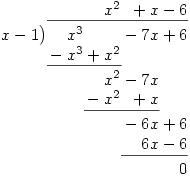Mathematics Weblog
Polynomial Division
Sunday 19 June 2005 at 2:50 pm | In Articles | 7 CommentsA long time ago UK students used to learn how to do polynomial long division before they were 16. Nowadays, they see little of it until they reach A level, and the new national syllabus expects them to learn the remainder theorem for AS (16+). They don’t actually need to do long division as examples are usually simple enough to allow one to guess factors; for example  and
and  has to be found. Nevertheless, it is useful to be able to do long division and, given the time constraints, I usually use Synthetic Division.
has to be found. Nevertheless, it is useful to be able to do long division and, given the time constraints, I usually use Synthetic Division.
 allows you not only to show the steps of either method, it will also do the mathematics for you, thanks to the polynom package. The code \polylongdiv{x^3-7x+6}{x-1} produces
allows you not only to show the steps of either method, it will also do the mathematics for you, thanks to the polynom package. The code \polylongdiv{x^3-7x+6}{x-1} produces

and \polyhornerscheme[x=1]{x^3-7x+6} gives
![\polyhornerscheme[x=1]{x^3-7x+6} \polyhornerscheme[x=1]{x^3-7x+6}](/maths/latexrender/pictures/0c5e48d1e6dc34e545214031b1df20fe.gif)
There’s lots more possibilities such as
![\polyhornerscheme[x=1,tutor=true,resultstyle=\color{blue},tutorlimit=8,stage=8]{x^3-7x+6} \polyhornerscheme[x=1,tutor=true,resultstyle=\color{blue},tutorlimit=8,stage=8]{x^3-7x+6}](/maths/latexrender/pictures/22a3dbebf1d5c92b10d574fbd7bdacb4.gif)
Brilliant! You can watch an online demo of the polynom package doing division step-by-step in a number of different ways here. Click to move the demo on, press Esc to end it.
Please note: \polyhornerscheme is not available in versions of polynom before version 0.16, so if you wish to use \polyhornerscheme do make sure you get the latest version, perhaps from here
Martin Gardner CD
Friday 10 June 2005 at 3:18 pm | In Articles | Post CommentFollow up to Martin Gardner’s Mathematical Games: The Entire Collection of His Scientific American Columns. This CD is now available at MAA Online Bookstore. As far as I know that’s the only place it’s available from which could make postage expensive for those of us outside the US – unless you know better?
Calculators
Thursday 9 June 2005 at 6:10 pm | In Articles | Post CommentThere is more emphasis these days in UK maths exams on not using calculators. This week, for example, for the first time students sat an AS exam (AS = halfway towards an A level) which didn’t allow calcuators. Many years ago when scientific calculators were first allowed questions were set that involved such large numbers that you couldn’t use a calculator directly but had to use logs.
In the US CNN.com reports that a student discovered that by pressing certain keys, they could get round the restrictions placed on them for their tests. I remember finding some years ago that statistical functions could be used on a calculator that didn’t appear to have that capabaility, provided you pressed a special button.
There’s no fooling budding mathematicians 😎
Powered by WordPress with Pool theme design by Borja Fernandez.
Entries and comments feeds.
Valid XHTML and CSS. ^Top^